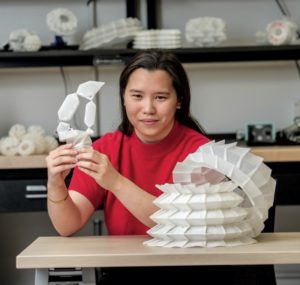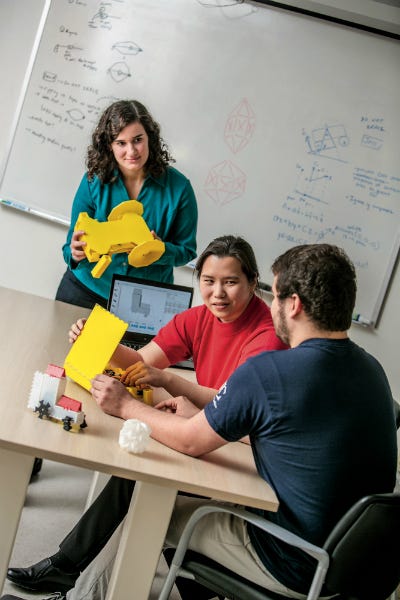The Democratization of Robots

Cynthia Sung, assistant professor in Mechanical Engineering and Applied Mechanics at the University of Pennsylvania
As the number of makerspaces across the world continues to grow, machines that cost up to hundreds of thousands of dollars a generation ago, like 3D printers and laser cutters, are becoming widely accessible and inexpensive. The trend has opened up endless new possibilities for the lay public to build and create. But there’s still a big hurdle for would-be inventors to overcome: In order to make something new and useful like a customized robot, you still have to have the skills to design it, which can involve years of learning and background knowledge. As a result, there’s a huge gap where the average person stops and a roboticist begins.
“Designing and making a robot has a lot of steps. First you have to come up with a design. Then you need the engineering knowledge to check that design. And you still need to learn the software to draw up the design. Only after all of that can you fabricate and test it,” says Cynthia Sung, assistant professor in Mechanical Engineering and Applied Mechanics at Penn Engineering.
Sung wants to change that imbalance. She’s working on tools for lay users that can democratize not only manufacturing, but also the basic elements of design — software that can work alongside nonexperts, providing engineering skills to fill any gaps in their knowledge.
The program she’s created, “Interactive Robogami,” is a computerized design tool that lets users build a virtual robot out of a library of basic body shapes, legs and wheels. Each component can be customized and arranged in any way a user wants, and when they’re done, the software will simulate their creation’s movements, its center of gravity and how it propels itself through the world. It’s a playful, iterative process, a bit like tinkering with LEGOs. But under the surface, Interactive Robogami is much more than just a toy.

One of the appeals of Robogami is the ability to rapidly iterate. Ideas mocked up in a computer program can quickly be turned into working prototypes. Here, Sung discusses the sequence for a new design with doctoral student Jessica McWilliams and MEAM senior Andres Zambrano.
“With existing design tools, most people spend a lot of time trying to understand how to use the software. Then they have to learn engineering to figure out what to design,” says Sung. “Interactive Robogami lets us combine those steps and make them more intuitive.” In other words, she adds, it lets humans and machines cooperate on the design process. Users supply the creativity; the computer supplies engineering principles to back it up, and it can make suggestions on the design process accordingly.
The tool also comes with another innovative feature. In addition to helping users in the design phase, the software also makes fabrication simple. The blocky, geometric shapes it generates aren’t accidental. Those forms allow the software to project a robot’s body into two dimensions, which users can then fabricate and fold into a 3D shape.
“It’s origami; you can cut the basic shapes out by hand if you don’t have a 3D printer or laser cutter. That means you can make the same robot out of cardboard, plastic, metal or pretty much any other foldable material. It lets us reach a much broader audience,” Sung says.
RETHINKING JOINTS
Sung’s interest in origami goes back to childhood. As a young girl, her mother taught her to fold cranes, a classic origami shape. Watching paper take on new properties as it became a 3D object fascinated her, and eventually led her to study the mathematics behind it in high school and college. That’s when it dawned on her that it could be a powerful tool for robotics.
“Just like folding a crane, a single sheet of material can become whatever structure you want. If you cut the sheet and fold it in different ways, you can get robots that look and move however you want, so you don’t have to build extra parts,” she says.
A perfect example of this, Sung notes, is a lowly hinge. The metal ones holding your front door together serve a useful purpose, but are relatively complex to make. Each one has at least three metal parts (two sides and an axle), all of which have to fit precisely into the others for the door to swing open.
“However, if you take a piece of paper and you just fold it once, that’s a hinge. All the complexity of those three metal pieces with an axle down the middle goes away because the action of the hinge is embedded in the fold itself,” Sung says. “You can extrapolate that idea to form complex joints. Pretty much every joint can be broken down into a series of hinges. If you arrange them in the right way, you can get a huge range of motion.”
That’s useful in any robotics application, but it’s especially handy when it comes to miniaturization. As robots become increasingly small and compact, building joints, hinges and other parts becomes a major engineering challenge, driving up price and complexity. Robogami techniques, however, would let users fold them into shape from a single material, easing the fabrication process.
Sung is also working with materials that can fold themselves. By cutting tiny robotic forms out of materials that are heat sensitive, she’s been able to make shapes that curl up at specific points when exposed to hot air or water. In the future, that could make it simple to create small robots quickly. “You’d design a robot using interactive tools, print it out and bake it, and your robot could potentially walk out of the oven,” she says.
WORKING ACROSS FIELDS
Sung is quick to note that it’ll be a while before this technique can be used to create actual working robots. At the moment, it’s still experimental, but it represents an interdisciplinary way of thinking that she encourages in all her students.
“One of the students in my lab took a class in fluid dynamics and became very interested in the subject. He’s now studying and characterizing the hydrodynamics of some origami patterns that may one day become underwater robots. That was totally unexpected. I never thought we’d be looking at how much drag an origami shape experiences,” she says.
It’s a perfect example of how experimenting with robots, especially foldable ones, means going beyond the boundaries of a single field and applying skills from seemingly unrelated areas.
As robots become more ubiquitous in the future, Sung notes, the ability to apply that level of creativity to them will be key to democratizing their use. Imagine one day being able to whip up a quick robot to help you clean a hard-to-reach storm drain, or to just entertain your cat while you’re away for a weekend. With the right design and fabrication tools, the idea isn’t so far-fetched.
“Right now, the technology isn’t there to help people build these one-off robots,” Sung says, “but design software like Interactive Robogami lets you intuit what design changes mean in the real world instead of using equations.” In other words, she says, it could remove some of the last major hurdles for makers so their creativity can flow freely, bringing a future of lay robotics one step closer to reality.







